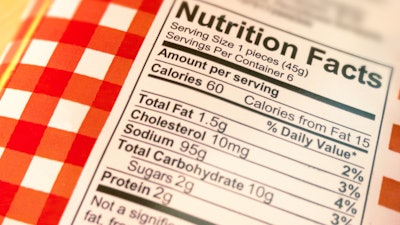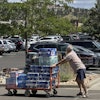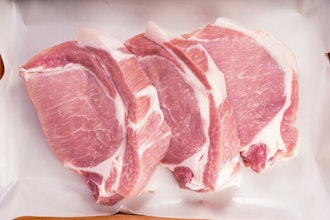
Recent disruption to raw material and supply chains has left manufacturers with no alternative but to substitute ingredients to avoid product shortages or ceased operations, but this can open up a whole host of operational challenges, not least in terms of package labeling and artwork changes, argues Bob Tilling, VP of sales at Kallik. In this, the "era of the shortage," labeling and artwork must be updated regularly and often at short notice to ensure compliance – so business leaders must embrace technology to ensure ingredient substitutions run without disruption.
Many industries are facing widespread business challenges posed today by cost pressures such as inflation, raw material shortages, supply chain crunches and even natural events including limited harvests or severe weather.
Affected industries cover food and beverage, but also healthcare products, such as pharmaceuticals, and cosmetic lines, which have far more ingredients in each product than many consumers anticipate. As many ingredients have become scarce or expensive, manufacturers have had no issues sourcing alternatives – meaning substitutions are becoming more widespread. For example, a likely shortfall in sunflower oil caused by the conflict in Ukraine – the world’s largest supplier of the oil – has caused disruption for many food manufacturers, yet is already being actively mitigated by switching to rapeseed oil as a close alternative.
High demand & ingredients shortages bring a pattern of constant reformulation
The problem lies not with this product reformulation, but the ripple effect on operations such as labeling, artwork and packaging – all of which must be updated in line with any ingredient switches.
The ingredients issue is forcing change at a far greater pace than usual. U.S. consumer foods giant General Mills cited some products as being reformulated over 20 times between January and April. For comparison, many ingredient tweaks are typically a very rare occurrence, with adjustments to tried and tested formulations taking place perhaps every 2-3 years.
As manufacturers across multiple industries jostle to secure limited stocks of existing ingredients in what is a very fast-moving situation, some products may end up being repeatedly reformulated with alternatives on a regular basis during this ongoing ‘perfect storm’ of disruption.
But product formulation is far more than a simple ‘drag and drop’ activity during the manufacturing process – especially in highly-regulated industries such as pharmaceuticals, cosmetics, and food & beverage.
Don’t forget how essential product labeling is!
Packaging and labeling can often be an oversight in this current laser focus on ingredients supply and reformulation to ensure production continuity – but it plays an equally vital role in the overall process, and manually adjusting these assets can be a long, laborious process.
Indeed, a UK Food Standards Agency report on food substitution and labeling places label change lead times at 6-12 weeks – assuming disruption such as supply chain issues is not extending this even further.
If labeling and artwork cannot be adjusted at the same pace as product ingredients, production could be severely delayed or even halted. It is clear advanced technology is needed to cope with the impact of short-notice changes and bring agility to the artwork and label management process.
Digitally oversee end-to-end production
Any business with multinational operations or large product ranges will likely see a major impact to operations if they cannot identify and address ingredient changes on packaging in an agile, accurate manner – ideally from a ‘single source of truth’.
With many firms still outsourcing their product artwork and label management to local third-party agencies, dealing with ingredient shifts is a slow, costly process with no complete visibility of operations and an ever-present threat of inconsistencies introduced by human error.
This outdated process can today be phased out with the arrival of advanced, end-to-end label and artwork management (LAM) systems. Advanced LAM systems will offer features such as a ‘Where Used’ tool, to identify every instance of a specific ingredient used on every product label – in every language – and update accordingly.
Expect and plan for future disruption and regulatory change
Global disruption has reached unprecedented levels over the last few years – but further uncertainty for businesses and their supply chains could be on the horizon. Constantly shifting regulations on both a regional and national level are likely to cause business leaders to rethink their product formulations – think ‘sugar taxes’ requiring lower sugar content in the food & beverage industry.
Sugar taxes and shrinkflation are now on the agenda
We’re also currently seeing businesses across multiple industries – from cosmetics to consumer goods – adopt a ‘shrinkflation’ tactic, where products reduce in size while remaining the same price. Again, this will likely demand a change in product composition, with a knock-on labeling effect.
Ultimately, any change – whether imposed by supply chain disruption or even seasonal crop availability – will require ingredients to be updated or listed in a differing order on product packaging.
Proactivity is critical to avoid more disruption
As global businesses are continually vulnerable to various supply chain issues for critical ingredients and raw materials, a solid digital framework for problem reactivity and industrial agility is required. With constant concern over introducing unlabeled allergens into products, a digitized, consistent labeling approach has never been a higher business priority. As a result, tasks such as artwork and label design and updates will need to be afforded more attention as LAM solutions allow businesses to react quickly to changes in ingredient availability and avoid operational disruption.
Bob Tilling is vice president of sales at Kallik.





















